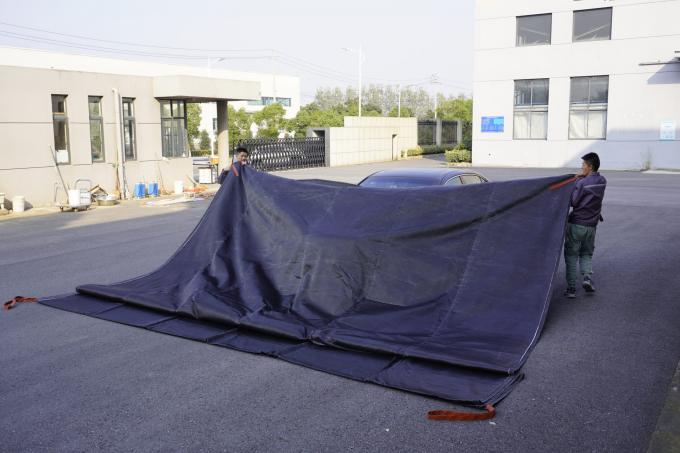
An EV car fire blanket is a critical safety tool designed to suppress and contain electric vehicle fires, particularly those caused by lithium-ion battery thermal runaway. These blankets must be highly heat-resistant, durable, and capable of preventing flames, smoke, and toxic fumes from spreading. Below is an in-depth look at the primary materials used in their construction:
Heat Resistance: Withstands temperatures up to 1,800°F (982°C) continuously, with short-term resistance up to 3,000°F (1,650°C).
Properties:
Made of over 96% silica, making it highly fire-resistant.
Non-combustible and resistant to molten metal splashes.
Provides excellent thermal insulation and fire containment.
Remains stable under extreme heat without breaking down.
Why it’s used: High-silica fabric is one of the best fire-resistant textiles, making it a key component in EV fire blankets. It effectively suppresses battery fires by isolating oxygen and preventing further ignition.
Heat Resistance: Typically withstands up to 1,500°F (815°C).
Properties:
Composed of woven glass fibers, making it highly heat-resistant.
Lightweight and flexible, allowing for quick deployment.
Often coated with silicone or polyurethane (PU) for added water resistance, durability, and improved handling.
Non-toxic and chemically resistant, making it suitable for industrial fire protection.
Why it’s used: Fiberglass is a common fire-resistant material that provides an affordable yet effective barrier against flames and heat. The silicone or PU coating enhances its performance by making it more durable and resistant to moisture, smoke, and chemical exposure.
Heat Resistance: Withstands up to 2,000°F (1,093°C).
Properties:
Increased fire resistance compared to regular fiberglass.
Improves insulation by reducing heat transfer through the fabric.
Protects against molten metal splashes, making it ideal for extreme fire situations.
Non-toxic and eco-friendly, safe for use in industrial and emergency scenarios.
Why it’s used: The vermiculite coating enhances fire resistance, making it ideal for extreme heat conditions, including lithium battery fires. It also improves the durability of the fire blanket, ensuring long-term performance.
Heat Resistance: Can withstand up to 1,000°F (537°C) continuously, with short-term resistance to higher temperatures.
Properties:
Extremely strong and tear-resistant, preventing the blanket from ripping under stress.
High heat and flame resistance, making it suitable for industrial-grade fire suppression.
Lightweight yet durable, allowing for repeated use.
Chemical and abrasion-resistant, increasing longevity.
Why it’s used: Kevlar (a type of aramid fiber) is used to reinforce the fire blanket, making it more durable and resistant to wear and tear. This is crucial for large fire blankets that need to be dragged over a burning vehicle without damage.
Heat Resistance: Reflects up to 90% of radiant heat.
Properties:
Reflects extreme radiant heat and flames, improving fire suppression.
Reduces heat transfer through the blanket, protecting surroundings.
Adds extra durability and resistance to thermal degradation.
Commonly used in high-performance industrial fire blankets.
Why it’s used: An aluminized layer can reflect intense heat, keeping it contained within the blanket and preventing it from spreading to nearby objects or people.
Heat Resistance: Typically withstands up to 1,000–2,000°F (537–1,093°C).
Properties:
Made from materials like Kevlar or fiberglass.
Ensures seams remain intact under extreme heat.
Resistant to burning, melting, or weakening under fire exposure.
Why it’s used: High-temperature thread ensures that the blanket’s structure remains intact even when exposed to flames, preventing it from falling apart during critical fire emergencies.
Electric vehicle fires burn at extreme temperatures, often exceeding 1,800°F (982°C) due to lithium-ion battery thermal runaway.
The materials used in an EV fire blanket must:
Contain and suppress fires quickly by cutting off oxygen.
Resist extreme heat without breaking down.
Be strong and tear-resistant to cover entire vehicles.
Minimize toxic smoke and fume exposure.
EV car fire blankets are constructed using high-performance, heat-resistant materials like high-silica fabric, fiberglass, vermiculite coatings, aramid (Kevlar) reinforcements, and aluminized coatings. These materials ensure maximum fire containment, durability, and protection against extreme heat. Proper selection and combination of these materials allow fire blankets to effectively suppress dangerous lithium-ion battery fires, making them a vital safety tool for EV owners, firefighters, and emergency responders.